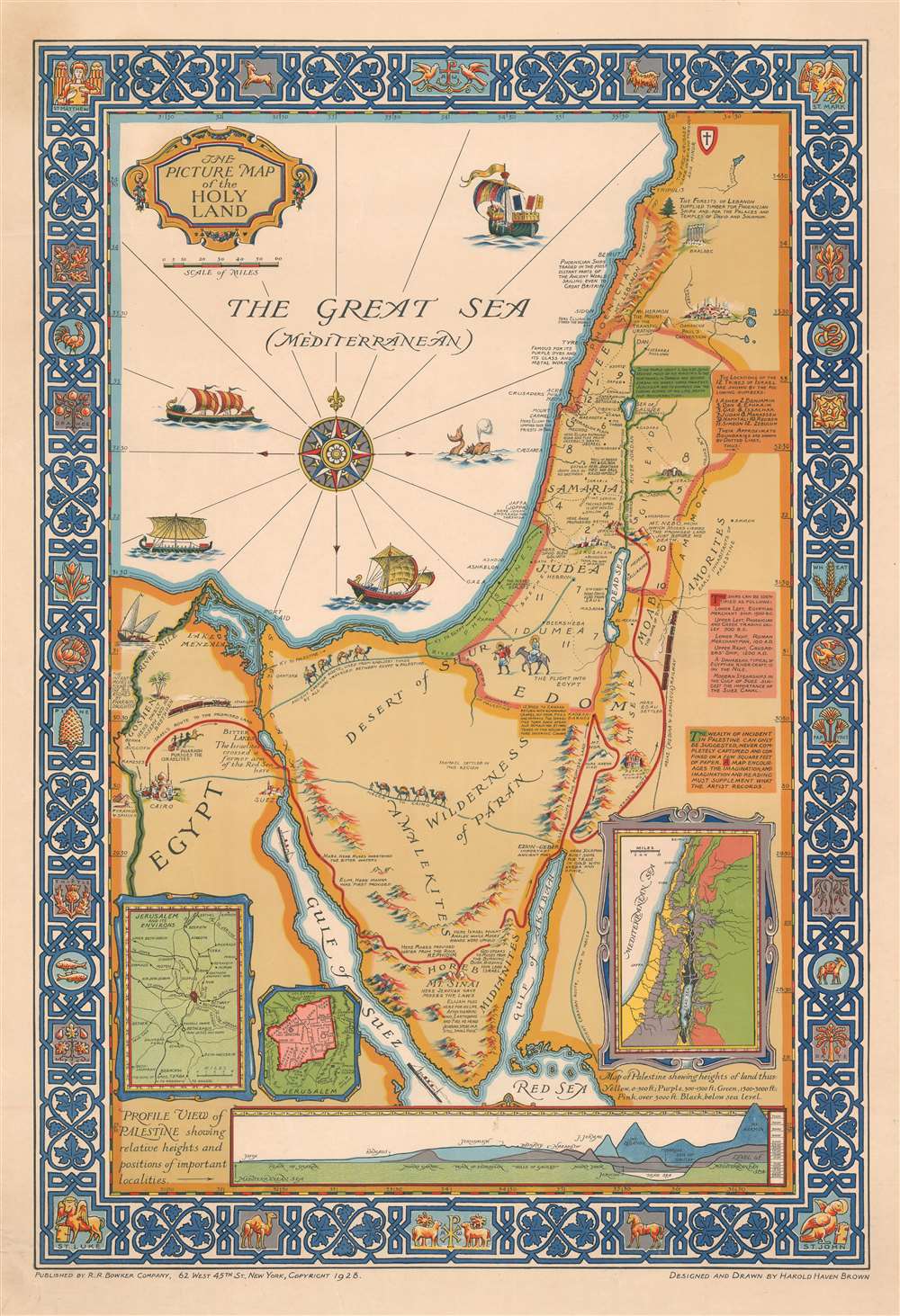This item has been sold, but you can get on the Waitlist to be notified if another example becomes available, or purchase a digital scan.
1928 Harold H. Brown Pictorial Map of the Holy Land / Israel / Palestine w/ Sinai
PictureMapHolyLand-brown-1928-2
Title
1928 (dated) 31.25 x 22 in (79.375 x 55.88 cm) 1 : 1300000
Description
Sites of Biblical Importance
Brown relates key events from the Bible, including the site of where David slew Goliath, Jonah's point of embarkation at Jaffa, where John the Baptist preached and baptized, the site of Aaron's death, and the location where Esau settled. The Israelites' flight from Egypt and their subsequent wanderings are traced and important events on the journey are noted. A green text box near the Sea of Galilee summarizes Jesus's life and work geographically, while yet another text box explains how the Twelve Tribes of Israel are referenced. A vignette near the Egyptian border depicts the flight of Joseph, Mary, and the infant Jesus fleeing to Egypt to escape the wrath of King Herod.Secular and Historical References
Not every reference included by Brown is strictly Biblical. Cities and towns throughout are identified, with Jerusalem, Jericho, Damascus, Suez, and Cairo each meriting a small illustration. A view of the Pyramids of Giza and the Great Sphinx is included near Cairo. Ancient caravan routes from Egypt to Palestine and from Mecca to Cairo are traced and feature illustrations of caravans. Modern transportation routes including the Medina and Damascus Railway, and the Egypt and Palestine railway. References are made to the prowess of ancient Phoenician sailors and traders and the renown of dyes, glass, and metal work from Tyre. A shield of the Knights Templar situated in the upper right, visually invoking the 1097 First Crusade. An annotation describes the importance of Lebanese timber, used in antiquity to build Phoenician ships and the temples of David and Solomon. A text box situated along the right border identifies the six different ships illustrated on the map: Egyptian, Phoenician, Roman, a Crusader's ship, an Egyptian river boat, and a modern steamship meant to reference the Suez Canal.The Insets
Four insets are situated in the bottom third of the map. The first, along the right border, is a topographical map of Palestine highlighting elevation. The second and third focus on Jerusalem. The smaller of the two is a plan of the Old City. The second is a map of Jerusalem and its environs. The final inset is a profile view of Palestine underscoring the dramatic topographical transition from the Dead Sea, which is below sea level, to Mt. Hermon, well above 7000 feet. The whole is surrounded by a decorative border featuring 'tile' bearing illustrations of important crops and vegetation and the symbols of St. Matthew, St. Mark, St. Luke, and St. John.Publication History and Census
This map was created and drawn by Harold Haven Brown and published by the R.R. Bowker Company in 1928. Only one example is recorded in the OCLC, part of the David Rumsey Map Collection at Stanford University.CartographerS
Harold Haven Brown (June 6, 1869 - April 7, 1932) was an American artist, cartographer, illustrator, teacher, painter, and museum director. Born in Malden, Massachusetts, Brown attended the Massachusetts Normal Art School before heading to Paris, France to study with Jean Leon Gérôme at the École des Beaux-Arts and with J.P. Laurens at the Académie Julian. Brown also spent significant amounts of time studying museum work at the Louvre, the Musée de Cluny, and the Musée du Luxembourg. He married Florence Bradshaw, a fellow artist, on November 4, 1897. The couple lived in Chicago and then Indianapolis, where Brown served as the director of the John Heron Institute, holding the position from 1913 until 1921. They then moved to Provincetown, Massachusetts in 1923. Brown was a noted mapmaker, and also created woodcuts and watercolors. He also wrote books and articles on calligraphy and on decorative, pictorial, and mechanical drawing. He and Florence played an important role in the founding of the Provincetown Art Association and Museum and Brown served as its president from 1926 until his death in 1932. He and Florence had two children. More by this mapmaker...
The R.R. Bowker Company (1868 - present) is an American company currently based in New Providence, New Jersey that provides bibliographic information on published works to the books trade, including publishers, libraries, booksellers, and individuals. Bowker is also the exclusive U.S. agent for issuing International Standard Book Numbers (ISBNs). The company was founded in 1868 in New York City by Frederick Leypoldt, a bookseller, to provide and compile bibliographic information with the goal of making the book business more efficient. He established the Literary Bulletin, his first periodical, that year and in 1870 issued the first edition of his Annual American Catalogue, the forerunner of Books in Print. The first issue of Publisher's Weekly was published in 1872, with the first issue of Publishers' Uniform Trade-List Annual appearing in 1873, and followed by the first issue of Library Journal in 1876. The company was acquired by Richard Rogers Bowker in 1878. The pair then founded two influential book-industry references: Literary Marketplace and Ulrich's Periodicals Directory. The R.R. Bowker company was acquired by the Xerox Corporation in 1967, which then sold it to Reed International in 1985. Also in 1985, Publisher's Weekly was transferred to the Cahners Publishing Company after 113 years as part of the R.R. Bowker Company. The Cambridge Information Group bought Bowker in 2001, and sold Literary Marketplace in 2007. After the Cambridge Information Group acquired ProQuest Information and Learning, R.R. Bowker was position as an affiliate of ProQuest. Learn More...

